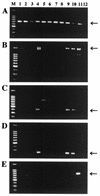Novel clade of Rickettsia spp. from leeches
- PMID: 11823253
- PMCID: PMC126704
- DOI: 10.1128/AEM.68.2.999-1004.2002
Novel clade of Rickettsia spp. from leeches
Abstract
Intracellular rickettsia-like structures were found in the tissues of a glossiphoniid leech, Torix tagoi, by transmission electron microscopy. Diagnostic PCR analysis using specific primers suggested that of the nine glossiphoniid species examined, two species, T. tagoi and Hemicrepsis marginata, harbored bacteria of the genus Rickettsia. A 1.5-kb eubacterial 16S rRNA gene segment obtained from each of these species was amplified by PCR, cloned, and sequenced. Phylogenetic analysis of the 16S rRNA gene demonstrated that the Rickettsia species found in the leeches constituted a novel clade that is distinct from the clade of arthropod-associated Rickettsia species. In natural populations, 97.7% (43 of 44) of T. tagoi leeches and 100% (9 of 9) of H. marginata leeches carried Rickettsia, suggesting that infection with Rickettsia is prevalent in these leeches. This is the first report of Rickettsia found in annelids.
Figures



References
-
- Buchner, P. 1965. Endosymbiosis of animals with plant microorganisms. Interscience, New York, N.Y.
-
- Chen, D. Q., B. C. Campbell, and A. H. Purcell. 1996. A new Rickettsia from a herbivorous insect, the pea aphid Acyrthosiphon pisum (Harris). Curr. Microbiol. 33:123-128. - PubMed
-
- Dasch, G. A., and E. Weiss. 1992. The genera Rickettsia, Rochalimaea, Ehrlichia, Cowdria, and Neorickettsia, p. 2407-2470. In A. Balows, H. G. Truper, M. Dworkin, W. Harder, and K.-H. Schleifer (ed.), The prokaryotes, vol. 3. Springer-Verlag, New York, N.Y.
-
- Davis, M. J., Z. Ying, B. R. Brunner, A. Pantoja, and F. H. Ferwerda. 1998. Rickettsial relative associated with papaya bunchy top disease. Curr. Microbiol. 36:80-84. - PubMed
-
- Folmer, O., M. Black, W. Hoeh, R. Lutz, and R. Vrijenhoek. 1994. DNA primers for amplification of mitochondrial cytochrome c oxidase subunit I from diverse metazoan invertebrates. Mol. Mar. Biol. Biotechnol. 3:294-299. - PubMed
Publication types
MeSH terms
Substances
Associated data
- Actions
- Actions
LinkOut - more resources
Full Text Sources
Molecular Biology Databases
Miscellaneous

